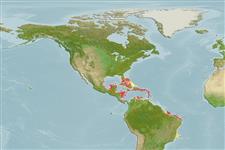Demospongiae |
Haplosclerida |
Phloeodictyidae
Environment: milieu / climate zone / गहराई सीमा / distribution range
पारिस्थितिकी
प्रवाल-भित्ति संयुक्त; खारा; गहराई सीमा 3 - 5 m (संदर्भ 415). Tropical
Western Central Atlantic: Caribbean.
Length at first maturity / आकार / Weight / Age
परिपक्व अवधि: Lm ? range ? - ? cm Max length : 6.0 cm H पुल्लिंग / अलिंग; (संदर्भ 415)
Yellow tube bearing oscula: 1 - 6 cm high; 0.9 - 3 cm wide, coming out of dead coral, with or without tissue covered by inhalant papilla. Excavating sponges, bright yellow sometimes with reddish tinges externally, and lighter yellow internally. Surface micro hispid, and sinuous. High quantities of mucus released when broken (Ref. 415).
Depth based on the Caribbean from Ref. 415. Restricted to the lower buttress zone, fore reef, and fore reef slope of fringing barrier-type reefs at depths between 1.5 to 70 m (Ref. 892). Also found in mangroves (Ref. 86836).
Life cycle and mating behavior
परिपक्व अवधि | पुनरुत्पत्ति | मछलीऔ का अंडे देना | Eggs | Fecundity | Larvae
Members of the class Demospongiae are hermaphroditic. Life cycle: The zygote develops into parenchymella larva (free-swimming) before settling down on a substrate where it grows into a young sponge.
Collin, R., M.C. Díaz, J. Norenburg, R.M. Rocha, J.A. Sánchez, M. Schulze, A. Schwartz and A. Valdés 2005 Photographic identification guide to some common marine invertebrates of Bocas Del Toro, Panama. Caribbean Journal of Science. 41(3):638-707. (संदर्भ 415)
IUCN Red List Status
(संदर्भ 130435: Version 2025-1)
CITES status (संदर्भ 108899)
Not Evaluated
CMS (संदर्भ 116361)
Not Evaluated
Threat to humans
Harmless
Human uses
| FishSource |
साधन
अधिक जानकारी
Trophic EcologyFood items (preys)
संघटक आहार
आहार खपत
परभक्षी
Population dynamicsबाढ़
Max. ages / sizes
Length-weight rel.
Length-length rel.
Length-frequencies
Mass conversion
बहुतायत
Life cycleपुनरुत्पत्तिपरिपक्व अवधिFecundityमछलीऔ का अंडे देनाEggsEgg developmentLarvae PhysiologyOxygen consumption
Human RelatedStamps, coins, misc.
इंटरनेट स्रोत
Estimates based on models
Preferred temperature
(Ref.
115969): 23.5 - 28.3, mean 27.5 (based on 413 cells).
Fishing Vulnerability
Low vulnerability (10 of 100).
Price category
Unknown.
